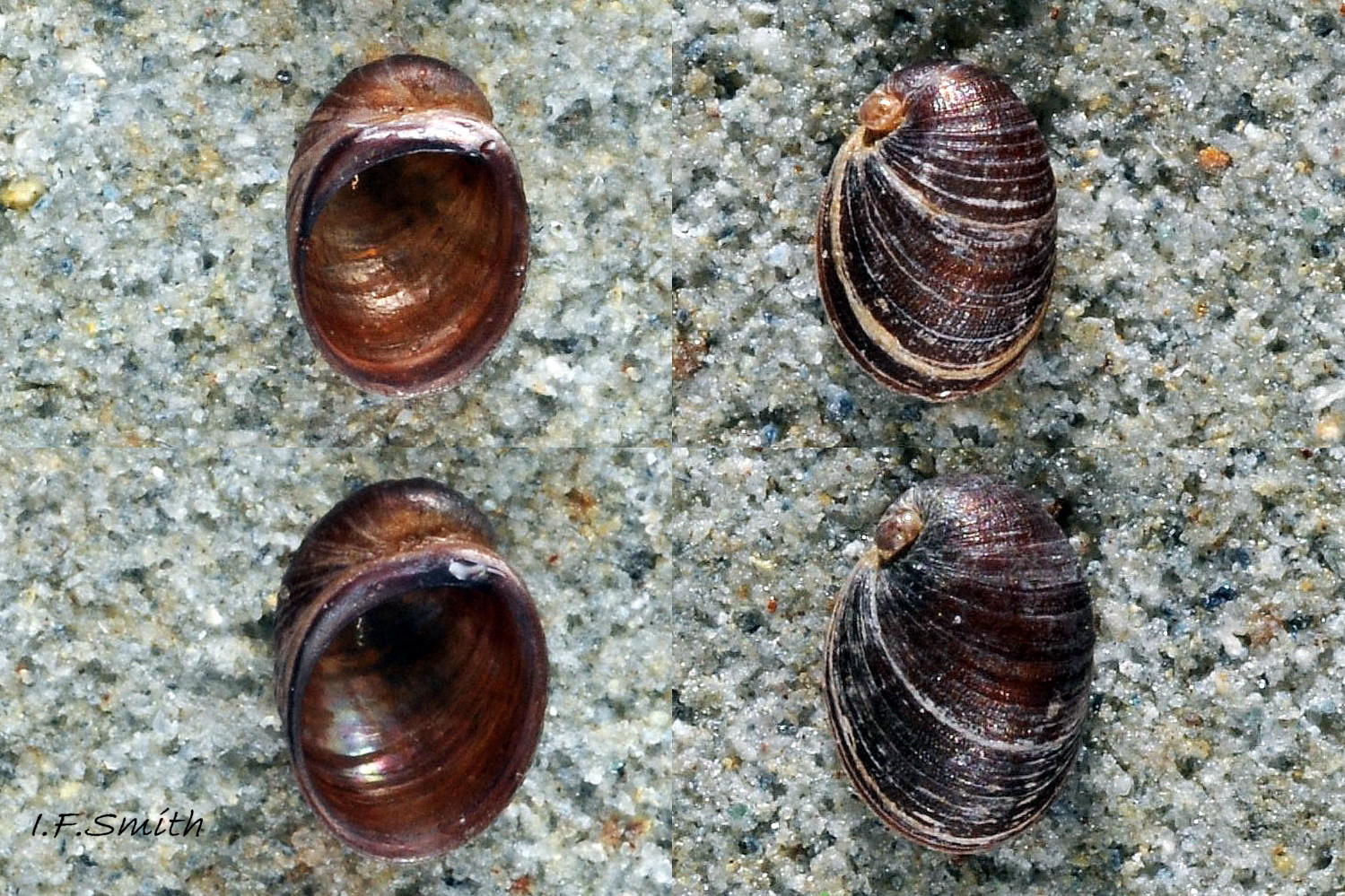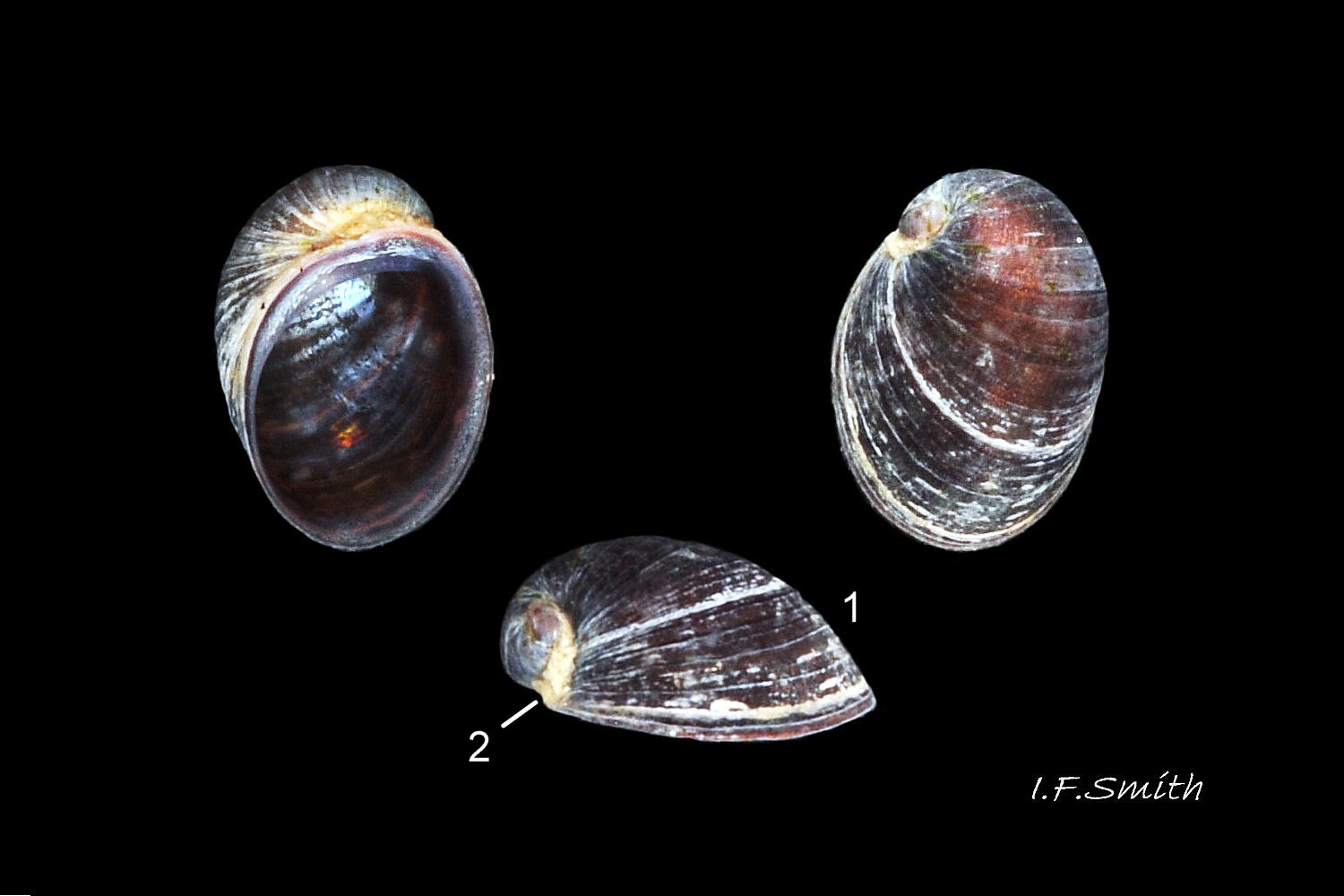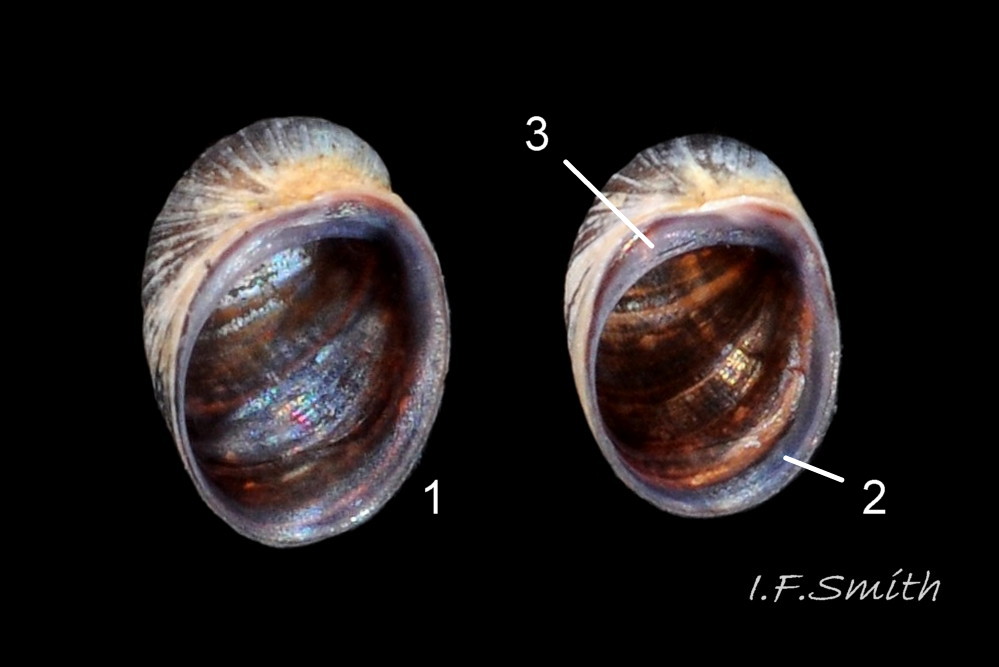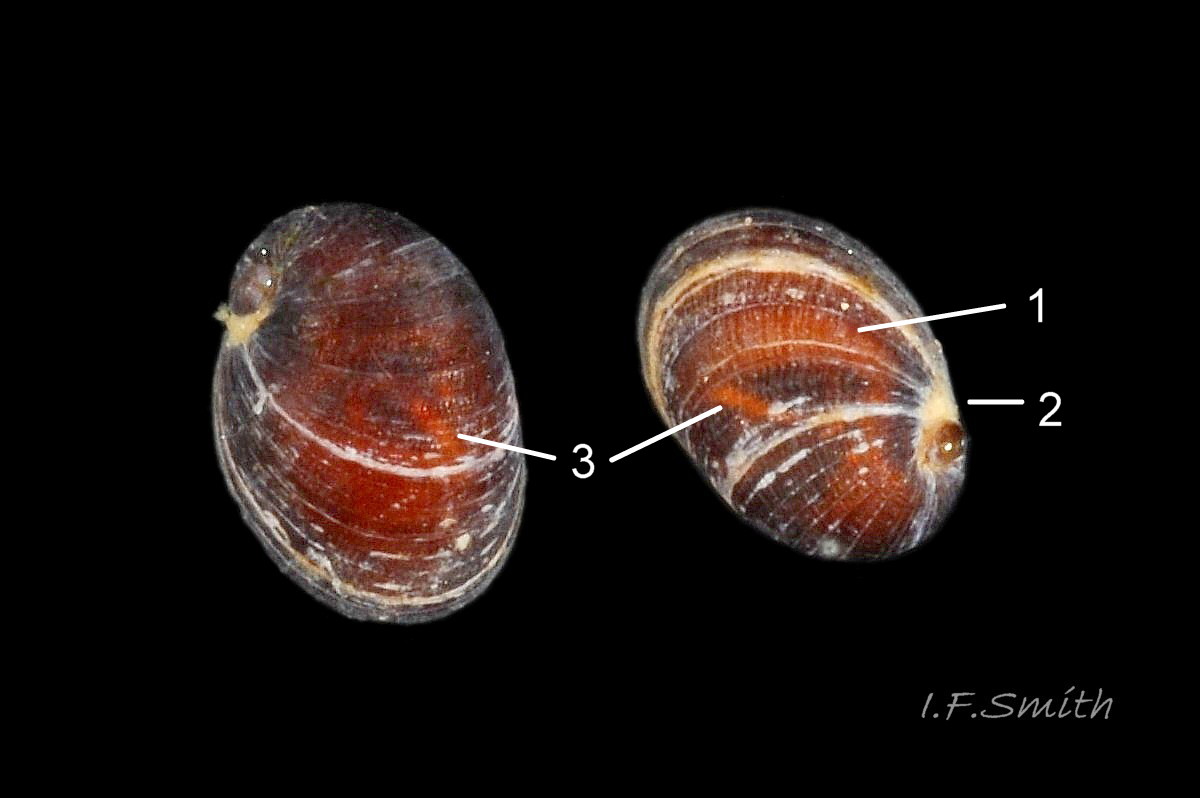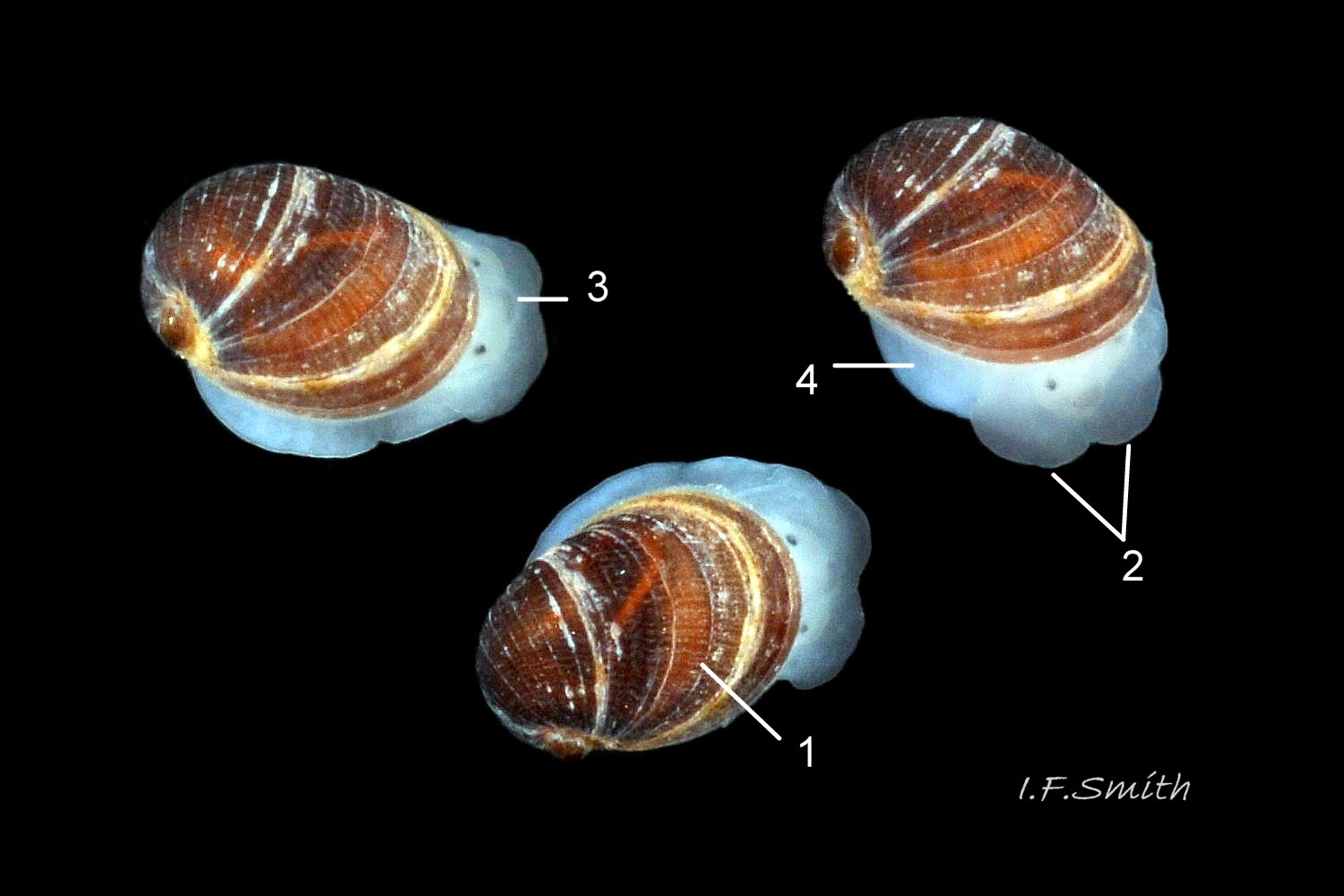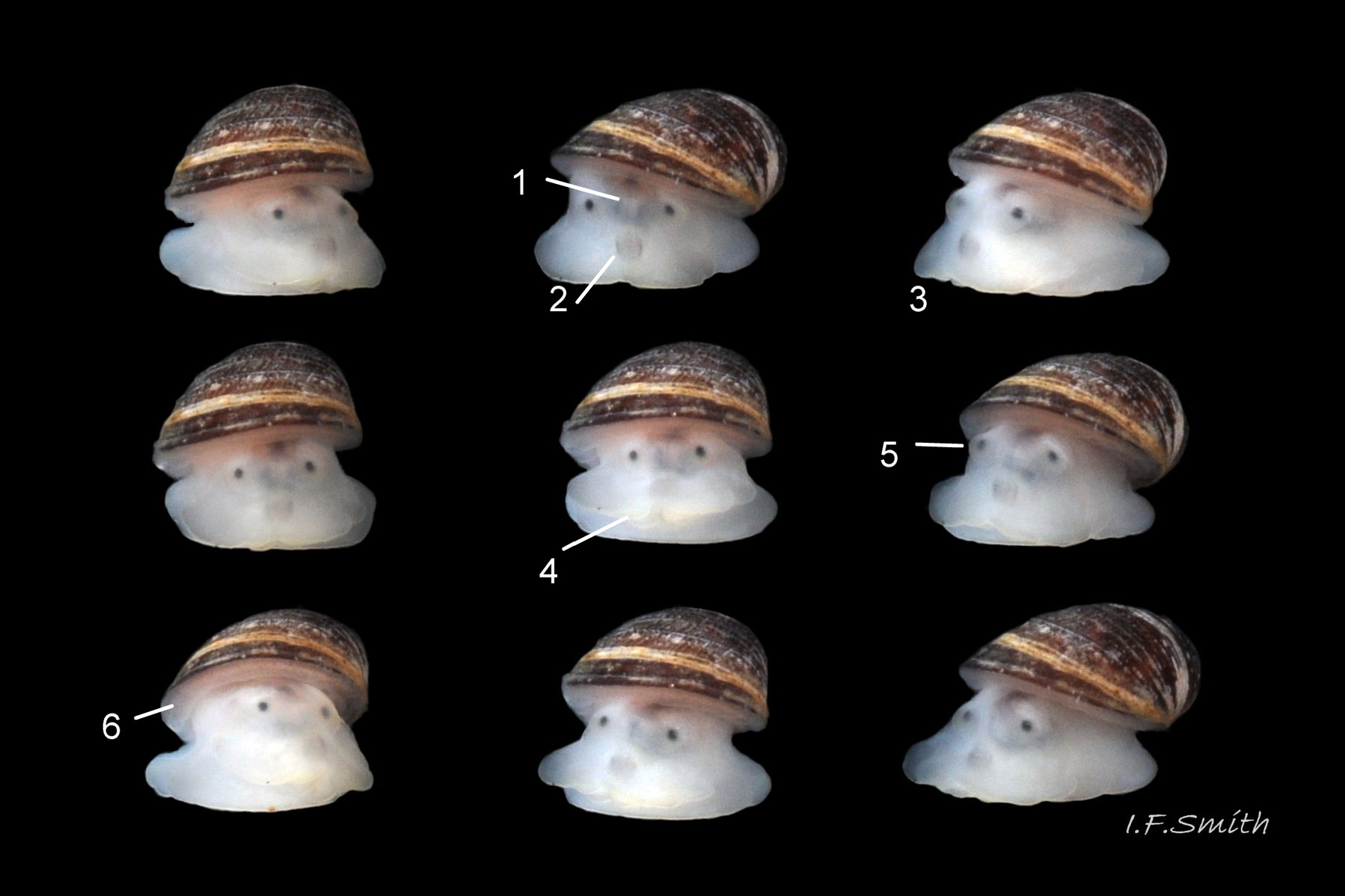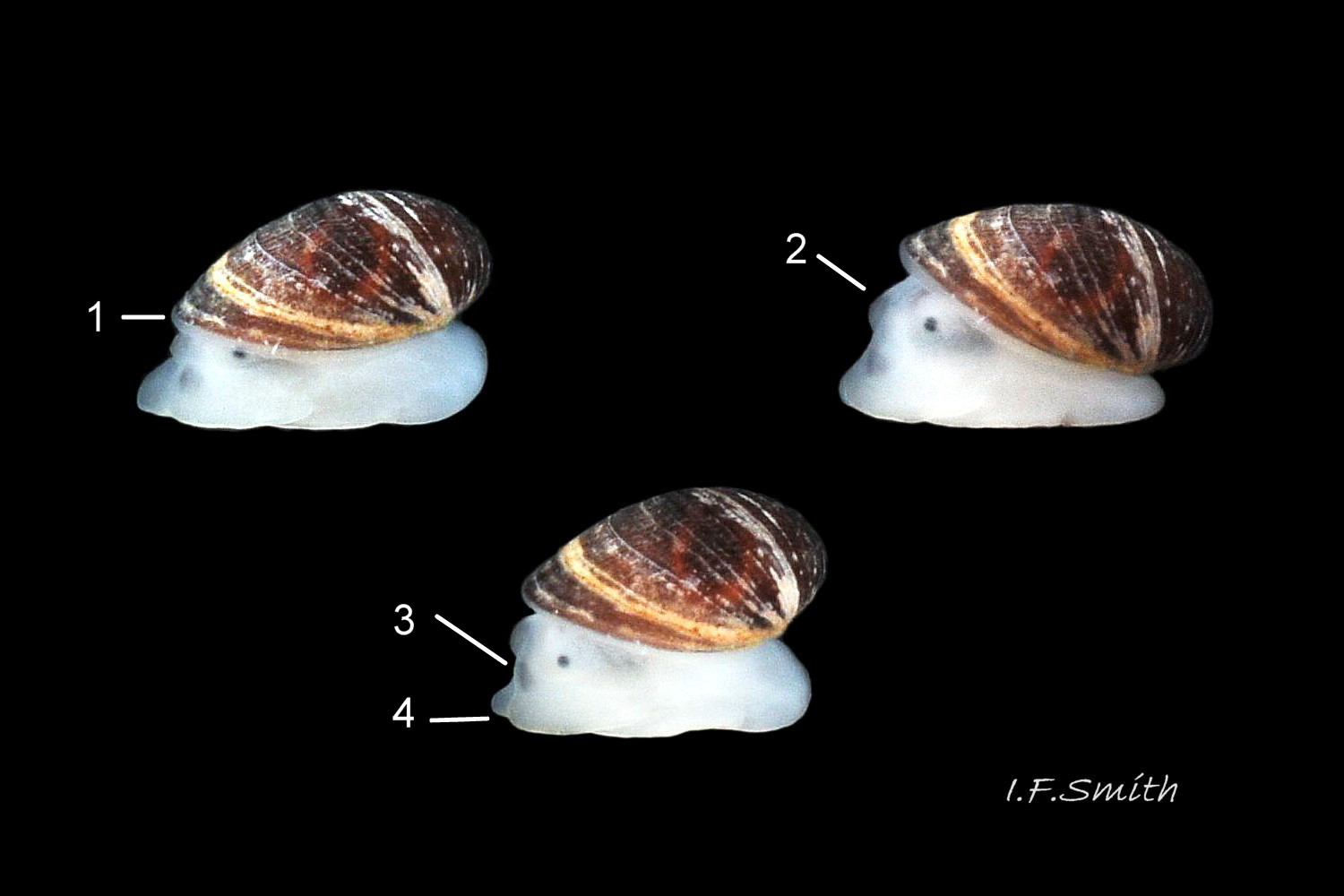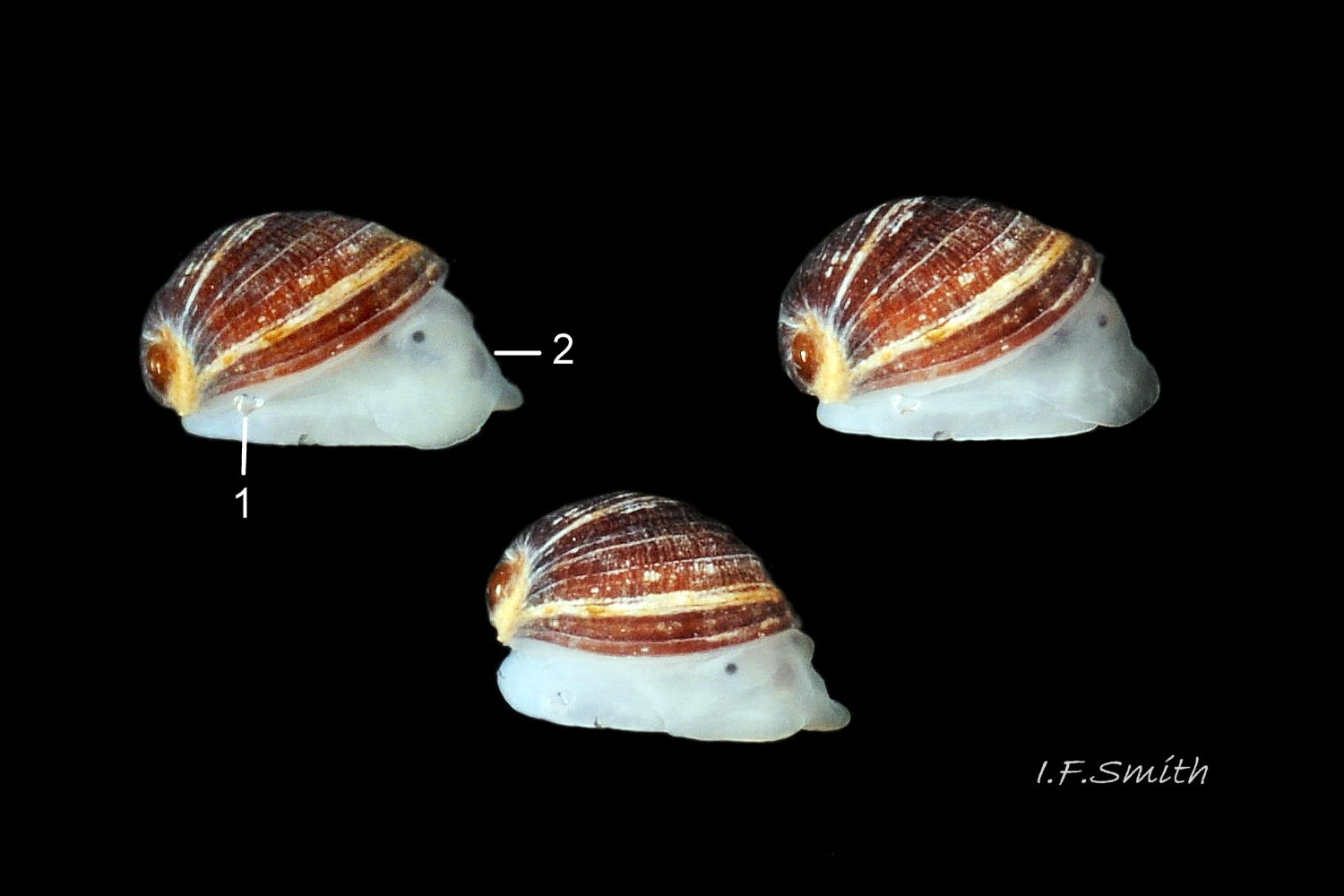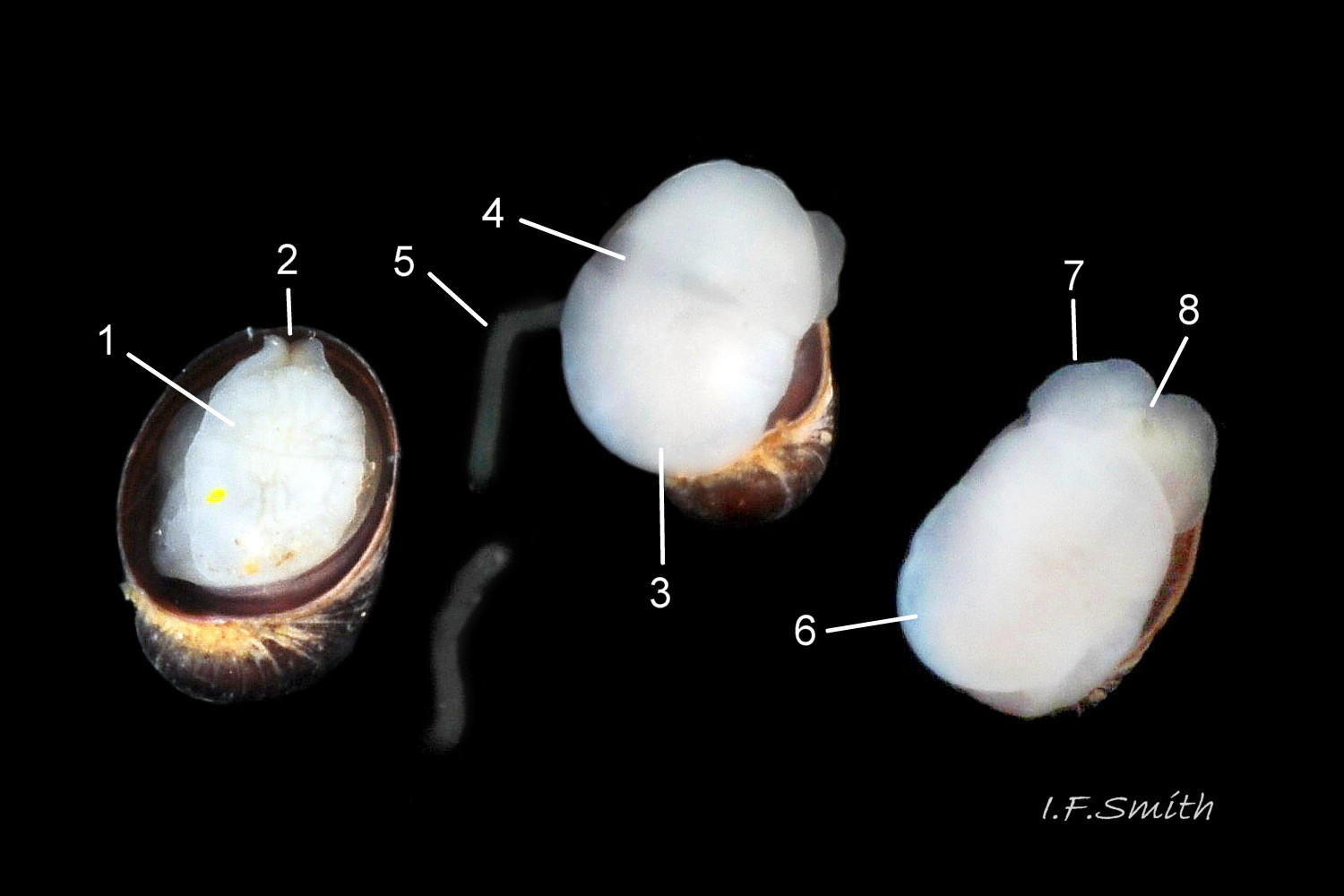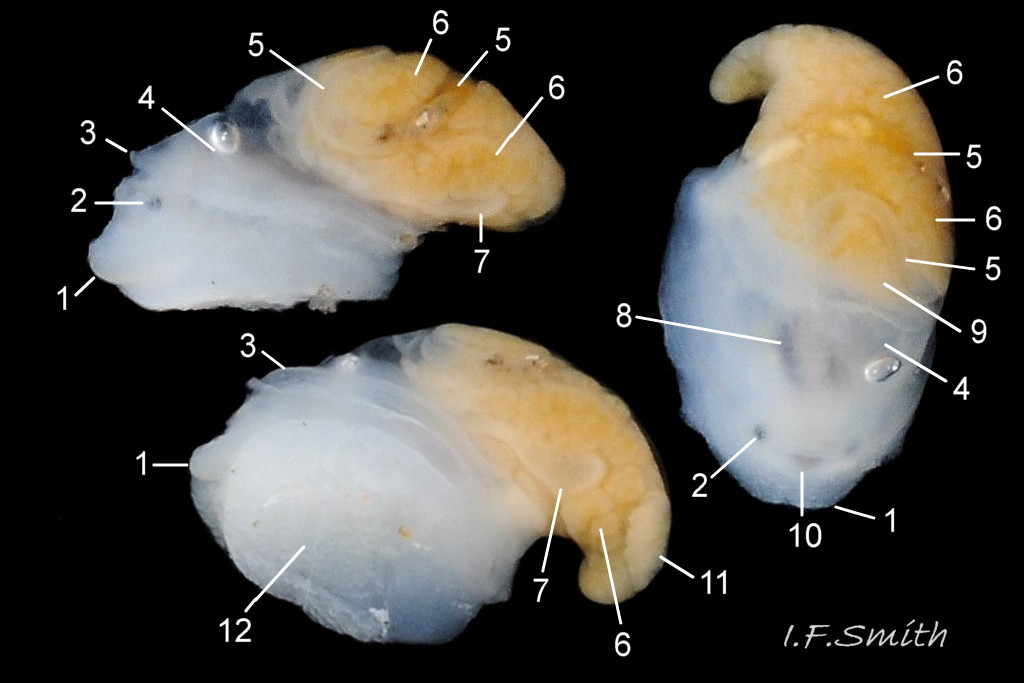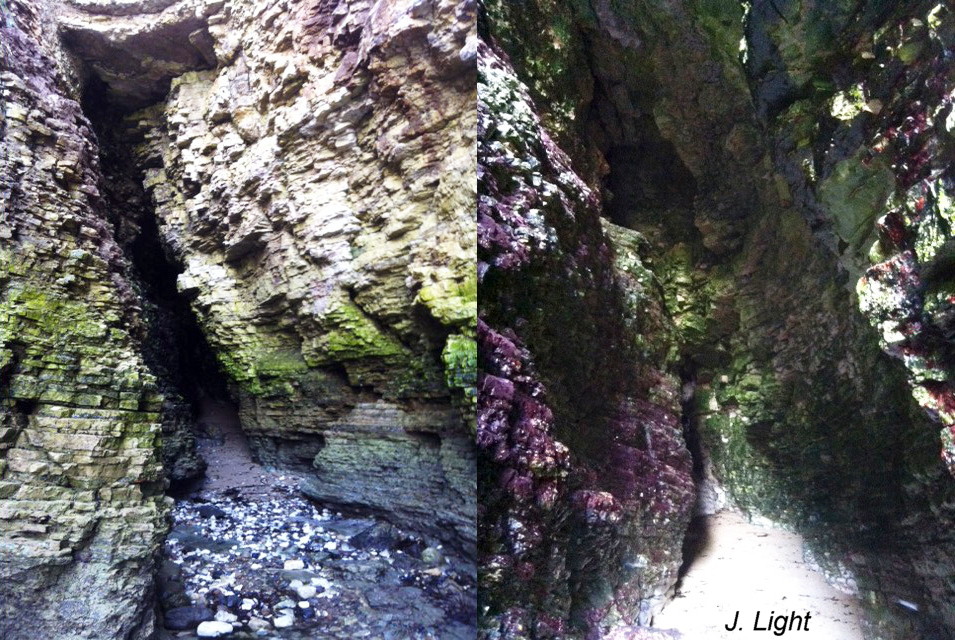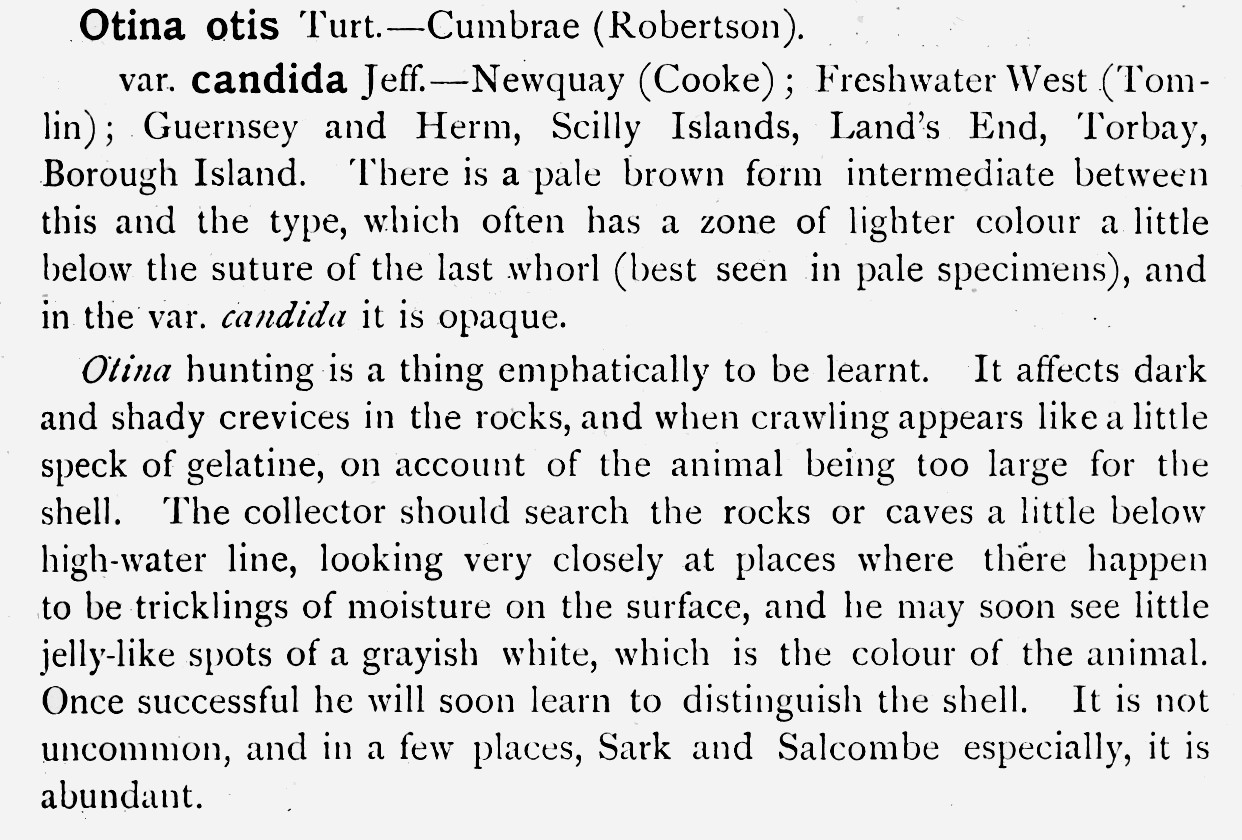Click image to enlarge with full caption. Main text below slider.
Otina ovata (Brown, 1827)
Illustrated pdf of this account available at
www.researchgate.net/profile/Ian_Smith19/contributions
Synonyms: Helix otis Turton, 1819; Otina otis (Turton, 1819); Gallericulum ovatum Brown, 1827.
Vernacular: Little ear-shell.
GLOSSARY BELOW
Shell Description
Usually up to 2.5mm long, maximum 3mm. Thin, semi-translucent. Very large body-whorl and single tiny bulbous spire-whorl forming lateral, inwardly-twisted apex; resembles tiny limpet or Haliotis shell 01 Otina ovata . Whorls distinctly convex, but in profile shell is a depressed dome 02 Otina ovata . Aperture ear-shape, very extensive but does not expose interior of spire. Interior glossy. Inner and outer lips together form uninterrupted rim. Outer (palatal) lip smoothly-curved and thin; paler band within rim is area outside of foot-muscle attachment. Inner (columellar & parietal) lip forms almost transparent whitish shelf; no umbilicus 03 Otina ovata . Exterior of shell superficially smooth, but magnification reveals sculpture of distinct growth lines and fine, regularly-spaced, parallel spiral striae forming lattice of oblongs 01 Otina ovata ; growth lines sometimes emphasized by debris lodged against them 04 Otina ovata . Colour various shades of brown 02 Otina ovata , often darkened to dark chestnut-brown or purple-brown by closely adhering periostracum; groups of white specimens sometimes found (Killeen & Light, 1990), and newly hatched young are transparent showing yellow yolk in viscera. No operculum.
Body Description
Flesh white, slightly translucent. Head has large oral veil of two oral lappets and no protruding snout 05 Otina ovata . Mouth a ventral slit between lappets 09 Otina ovata . Internal black sclerotized jaw near mouth shows as grey mark near junction of head and veil. Other blackish internal organs show grey through translucent head and body 06 Otina ovata . Strong short wide radula covers entire free surface of odontophore; up to 100 lateral teeth plus marginal teeth per row. Rudimentary cephalic tentacles consist of mound bearing large black eye 07 Otina ovata . Mantle white; thin and transparent over mantle cavity; reflected as white rim at edge of shell-aperture 07 Otina ovata . Mantle cavity has no special respiratory capillaries (usually present in less primitive pulmonates). Pneumostome near posterior of right mantle_rim 08 Otina ovata . Anus adjacent and anterior to pneumostome. Female and male genital openings on right side under posterior of oral lappet; penis a simple introverted tube. Foot white; sole oval, divided transversely at a third of way from anterior edge 09 Otina ovata .
Internal anatomy
Image 10 Otina ovata shows features visible in specimen extracted from shell; includes jaw, transparent mantle skirt over mantle cavity containing no ctenidium or special respiratory capillaries, horseshoe-shaped loop of intestine, digestive gland surrounding intestine, stomach, ovotestis and very small kidney.
Key identification features
·Otina ovata
·Minute (2mm long) limpet-form shell with tiny spire.
·Lives near HW mark in humid chasms and caves, and in crevices.
Similar species
Several species of small limpet in NW Europe might have juveniles around 2mm with small spire, but none lives at HW mark.
Habits and ecology
In humid shaded positions on clean rock from splash zone of MHWN down to EHWN, including moist walls of caves 11 Otina ovata , north facing walls of chasms and outer parts of not-heavily-silted crevices on north faces of reefs of slate, shale, chalk etc. Favours fissured rock, but not unstable rapidly-eroding outcrops. Unlikely to occur where turbid water deposits film of mud over rock surfaces.
Obligatory hygrophile, unable to survive constant immersion of entire 12-hour tidal cycle so not below EHWN, but needs air humidity near 100%, becoming shrivelled and inert after twelve hours at 90%. Negatively geotactic when submerged, promptly moving up to escape total immersion when possible 06 Otina ovata . If exposed to non-humid air, moves promptly to humid shelter if possible, or clamps down onto substrate if none accessible.
Often associated in crevices with Melarhaphe neritoides, Littorina saxatilis, Cingula trifasciata, Auriculinella bidentata, Lasaea adansoni, Spirorbis borealis (tube worm), and Chthamalus spp. (barnacles). On open surfaces, active during periods of wave-splash, and at other times may venture out in very humid weather, especially if can shelter in dead barnacle shell, tuft of Lichina pygmaea or byssus of small Mytilus edulis. Positively thigmotactic, so often found in packed groups of about ten that conserve moisture.
Respiration is with atmospheric air admitted to the mantle cavity through a pneumostome 08 Otina ovata , but, unlike most pulmonates, O. ovata lacks special respiratory capillaries in the mantle cavity 10 Otina ovata . Broad lateral tracts of foot-surface 05 Otina ovata may have accessory respiratory function as blood comes here to body-surface under very thin epithelium through which respiratory interchange might easily be possible (Morton, 1955); probably sufficient respiration for slow-moving animal with small volume.
Feeds by scraping wave-lodged diatoms and filamentous algae from rock surface with radula while jaw grips on substrate. Food particles compacted at mouth with copious mucus from suprapedal gland on upper surface of anterior lobe of foot. Stomach with rotating protostyle of mucus and faeces, similar to that of bivalves, is most primitive yet described in a pulmonate (Morton, 1955) 10 Otina ovata . Faecal string never compressed into pellets, much more loosely compacted than in prosobranchs 09 Otina ovata ; unlike them, has no ctenidium to be fouled and anus does not discharge into pallial cavity. Small kidney in front of looped intestine opens into pallial cavity with no water current to carry discharges out of cavity 10 Otina ovata ; probably assisted by accessory excretion from amoebocytes in broad lateral tracts of foot (Morton, 1955).
Travels by advancing anterior third of foot, fixing it to substrate and then bringing up the rest of the foot. Foot moved by muscles and disposition of blood in pedal sinus.
Breeding: protandrous hermaphrodite with no clear cut separation of male and female phases, each animal produces sperm in September – December, followed by an egg-producing phase December – June. Copulation with simple penis occurs before late March. Spawns in late May/ early June. Loose clusters of 20-30 eggs in tough, yellow/straw-coloured mucal secretion, 4-5mm across, loosely attached to substrate in humid conditions where adults live. Operculum, but no velum, present in embryos. Young hatch as crawlers with transparent shell revealing viscera yellow with egg-yolk in apical bulb. Uncertain if annual life cycle, but presence of all sizes simultaneously suggests biennial or longer.
Search technique “if properly searched for it would doubtless be found in every suitable locality” (Jeffreys, 1869).
Take a torch and large hand lens to help detect the tiny white glistening blobs of flesh, or, in late May and early June, the larger (4 or 5mm across) yellowish egg masses. Choose a humid misty day, if possible, as O. ovata is then more likely to emerge from cover, and visit as soon after high tide as access is possible; wellingtons or waders may help early access to caves with entrances still awash. Seek, in fissured rock, a cave or chasm that is narrow, so likely to retain humid air and exclude direct sun 11 Otina ovata . Search wet and damp rock faces around high water mark; sometimes different coloured algal films indicate differences of moisture. Shaded, north-facing faces of fissured reefs may have some within crevices, but splitting them open is destructive of the habitat and should be done very sparingly, if at all. If you take specimens for study, transport them in a wet air-tight box that preserves 100% humidity. At home keep box in a fridge between 6°C and 10°C. Examination and photography can be of animal in seawater to save from dehydration, but it will become inactive and drown if kept submerged for more than a few hours.
Also, see 12 Otina ovata. & 13 Otina ovata. .
Distribution and status
Sparse scattered records, but can be locally common. Probably overlooked because of its small size and specialized habitat requiring targeted searching, and unfamiliarity of recorders with it as often omitted from id guides of both terrestrial and marine molluscs. Known distribution: Britain, Ireland, Normandy and Brittany. Isolated records of beached dead shells from N.W. Spain, S. Portugal and Sardinia. GBIF map www.gbif.org/species/5189862 . NBN UK map species.nbnatlas.org/species/NBNSYS0000041447 has records on S. and W. coasts of Britain from Isle of Wight to Mull, but there were 19th Century east-coast finds in Northumberland and Yorkshire (Forbes & Hanley, 1853), and Jan Light found live specimens in N. Yorkshire in September 2014.
Acknowledgements
I am indebted to Dr Jan Light for providing specimens and sharing her expertise at the visit by the Conchological Society of G.B. & Ireland to N. Yorkshire in September 2014. I gratefully acknowledge Dr C.M. Cunha and Dr G. Rosenberg for help with sources and their interpretation.
Links and references
Eales, N.B. 1967. The Littoral fauna of the British Isles 4th ed. Cambridge, Cambridge University Press.
Forbes, E. & Hanley S. 1849-53. A history of the British mollusca and their shells. vol. 3 (1853) London, van Voorst. (As Otina otis; Free pdf at archive.org/details/historyofbritish03forb Use slide at base of page to select pp.320-323.)
Hayward, P.J. & Ryland, J.S. 1995. Handbook of the marine fauna of north-west Europe. Oxford, Oxford University Press.
Jeffreys, J.G. 1862-69. British conchology. vol. 5 (1869). London, van Voorst. (As Otina otis; Free pdf at archive.org/stream/britishconcholog05jeffr#page/108/mode/2up . Use slide at base of page to select pp.109-111.)
Killeen, I. & Light, J.M. 1990. Observations on Otina ovata (Brown): a little known pulmonate. J. Conch., Lond 33: 317 – 318.
McMillan, N.F. 1968. British shells. London, Warne.
Marshall, J.C. 1913. Additions to British conchology. Part 7. J. Conch., Lond. 14: 65-77. 12 Otina ovata.
Melville, J.C. 1918. Otina otis Turton at St Mary’s, Scilly. J. Conch., Lond. 15: 261. 13 Otina ovata.
Morton, J.E. 1954. The crevice faunas of the upper intertidal zone at Wembury. J. Mar. biol. Ass. U.K. 33: 187 – 224. plymsea.ac.uk/view/year/1954.html#group_M
Morton, J.E. 1955. The functional morphology of Otina otis, a primitive marine pulmonate. J. Mar. biol. Ass. U.K. 34: 113 – 150.
(Free pdf at core.kmi.open.ac.uk/download/pdf/6185241.pdf . pp144 – 145 missing from pdf). Also plymsea.ac.uk/view/year/1955.html#group_M
Sosso, M. & Dell’Angelo, B. 2010. Prima segnalazione di Otina ovata (Brown, 1827) (Systellomatophora: Otinidae) in Mediterraneo Boll. Malacol. 46: 1-3.
Current taxonomy: World Register of Marine Species (WoRMS) www.marinespecies.org/aphia.php?p=taxdetails&id=140661
Glossary
amoebocytes – mobile cells (moving by pseudopodia like amoeba) in invertebrate bodies that variously digest food, dispose of waste, fight infection etc.
aperture – mouth of gastropod shell; outlet for head and foot.
apical – at the apex.
cephalic – (adj.) of or on the head.
columella – solid or hollow axial “little column” around which gastropod shell spirals; hidden inside shell, except on final whorl next to lower part of inner lip of aperture where hollow ones may end in an umbilicus or siphonal canal.
columellar – (adj.) of or near central axis of spiral gastropod.
columellar lip – lower (abapical) part of inner lip of aperture.
coll. – in the collection of (named person or institution) (cf. legit).
ctenidium – comb-like molluscan gill; usually an axis with a row of filaments either side.
epithelium – tissue forming outer layer of body surface, “skin”.
EHWN – extreme high water neap tide (the weakest high tides of the year i.e. those that rise the least, usually near June and December solstices)
geotactic – (adj.) of species that moves towards pull of gravity (positively geotactic) or away from it (negatively geotactic). (Synonyms: gravitaxic, ? geotaxic.)
hygrophile – species that prefers moist conditions; often at water’s edge, but not permanently submerged. obligatory hygrophile – unable to survive out of moist conditions.
introverted – turned in on itself.
legit – (abbreviation; leg. or lgt.) collected/ found by (compare with coll.)
mantle – sheet of tissue that secretes the shell and forms a cavity for the gill in most marine molluscs (but not in adult nudibranchs), part or all of dorsal body surface when shell absent or internal.
MLWN – mean low water neap tide level (mean level reached by weakest low tides for a few days every fortnight. i.e. those that fall the least).
MHWN – mean high water neap tide level (mean level reached by weakest high tides for a few days every fortnight. i.e. those that rise the least).
odontophore – firm, approximately ellipsoid, structure of cartilage supporting radula. Protruded like a tongue to operate radula.
operculum – plate of horny conchiolin, rarely calcareous, used to close shell aperture.
oral lappets – flaps of flesh by mouth.
oral veil – flat anterior extension of head (may consist of lappets).
ovotestis – hermaphrodite organ serving as both ovary and testis.
palatal lip – outer lip of gastropod aperture.
pallial – (adj.) of the mantle.
parietal lip – (=parietal wall) part of inner lip of gastropod aperture, adapical of columellar lip.
pedal – (adj.) of the foot.
periostracum – thin horny layer of proteinaceous material often coating shells.
plankton – animals and plants that drift in pelagic zone (main body of water).
pneumostome – breathing pore in mantle of pulmonate molluscs.
protandrous hermaphrodite – each individual starts mature life as a functioning male, later changing to female function.
pulmonate – (adj.) of terrestrial and freshwater, air-breathing, slugs and snails.
radula – ribbon of chitinous teeth extruded on a tongue-like structure (odontophore) to rasp food.
rec. – recorded by (person who submitted record, may be different from leg. and coll. persons/institution).
sensu lato – (abbreviation s.l.) in the wide sense.
sensu stricto – (abbreviation s.s.) in the strict sense, excluding species that have been confused with it.
stria – very narrow spiral groove or ridge (plural: striae)
taxis – directional locomotary response to external stimuli such as light, gravity, temperature or chemicals.
thigmotactic – (adj.) of animal that moves towards (positively thigmotactic) or away (negatively thigmotactic) from physical contact with others.
umbilicus – cavity up axis of some gastropods, open as a hole or chink on base of shell, often sealed over.
velum – bilobed flap on veliger larva, with beating cilia for swimming.
